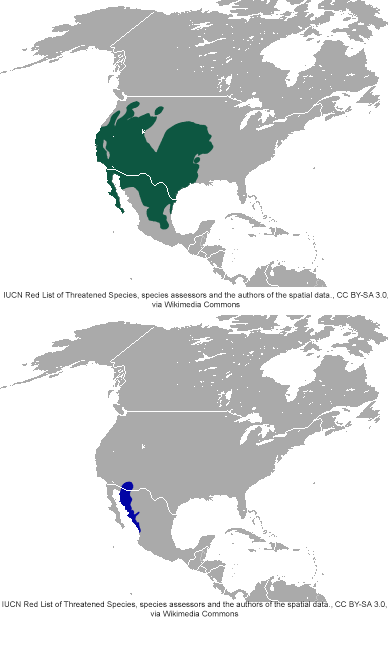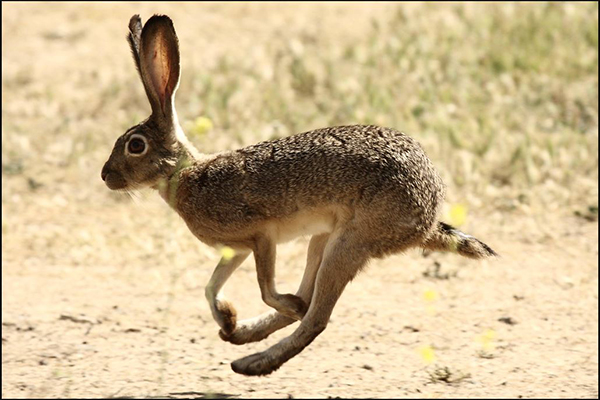Black-tailed and Antelope Jackrabbit

Canteloupe the antelope jackrabbit. Image credit: Arizona-Sonora Desert Museum
About
Jumpin’ jackrabbits — those are some hoppy hares! Compared to their fluffy rabbit cousin, the desert cottontail (Sylvilagus audubonii), jackrabbits are larger, leaner, longer, and speedier. Though often confused with rodents, both rabbits and hares belong to a group called lagomorphs (which have an extra pair of incisors compared to rodents.)
Adaptations
This animal’s big, beautiful ears act like radiators, thus helping them cool down and making jackrabbits especially well-adapted to warm climates. After a sprint to escape a predator or on a sweltering summer day, blood flow to the ears increases to release heat. On cold nights, they reduce blood flow to the ears to preserve heat. Their ears can be 8 inches (20 cm) long! Jackrabbits are mostly nocturnal, avoiding activity during the times that would cause them the most water loss.
Food Web
Hares are herbivores, feeding on grasses, twigs, leaves, clover, alfalfa, seeds, beans, and cacti. Moisture from cacti and other plants fulfills most of their water needs, but they readily drink water if it is available. They are also an important food source for many animals, including coyotes, hawks, eagles, foxes, bobcats, and humans.

Habitat and Range
Our desert hares prefer open, flat places — where they can see predators and flee if need be — along with desert scrub and mesquite grasslands. The antelope jackrabbit inhabits areas much drier than the black-tailed jackrabbit can tolerate.
The black-tailed jackrabbit (Lepus californicus) is found from Baja California and south-central Mexico to west-central and western United States. While the antelope jackrabbit&squo;s (Lepus alleni) range is limited to southern Arizona and northwestern Mexico and is often found along Mexico’s coastal foothills — making them unique to this region!

Black-tailed jackrabbit
Family Life
Jackrabbits do not live in burrows but will often rest in the shade during the heat of the day in a shallow depression under grass or bushes. These animals are social, sometimes congregating in large groups of 25 or more, especially on moonlit nights. They will often forage or rest in groups, relying on each other’s eyes and ears for protection. Females will give birth to 1 or 2 baby hares (called leverets) in thick brush or in depressions in the ground lined with fur.
Glossary
- Lean:
- without much fat.
- Incisor:
- A type of tooth at the front of the mouth, with a narrow edge adapted for cutting.
- Radiator:
- A device (like a set of pipes or tubes) that transfers the heat from a fluid to an object or area outside.
- Nocturnal:
- asleep during the day and awake/active at night.
- Leveret:
- A young hare, in its first year of life.
Fun Facts
- Jackrabbits’ long back legs help them run really fast — up to 40 miles per hour (almost 18 meters per second) in short bursts to escape predators!
- Unlike cottontail babies that are born blind, naked, and helpless, jackrabbit young are born furred and with their eyes open. They can move around just a few hours after birth.
- The antelope jackrabbit is one of the largest hares in North America, weighing 9 to 10 pounds (4-4.5 kg). The black-tailed jackrabbit is slightly smaller, ranging from 3 up to about 8 pounds (1.3-3.6 kg).
- Jackrabbits live an average of 2-5 years in the wild, and usually longer in a zoological setting.
- Hare-y Ears Experiment
Conservation
Jackrabbits are not threatened or endangered.
At The Museum

Visit Cantaloupe the antelope jackrabbit at our Life on the Rocks exhibit. Cantaloupe can often be found with her feathered roommate Churro the roadrunner! Watch video on Facebook. The exhibit is open year-round; rough terrain, but wheelchair accessible.
